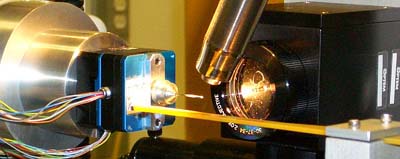Soon scientists at Argonne National Laboratory near Chicago, Ill., will test-drive what many call the “Ferrari” of synchrotron beamlines — high-tech research facilities for imaging molecules. During a dedication ceremony on Monday, June 27, researchers will tour the facilities and watch experimental demonstrations on one of three new beamlines that promise to speed medical research.
GM/CA CAT goniometry with on-axis visualization Several novel design features that allow for automation, additional research stations, and more refined data will enable researchers to study molecules in greater detail and translate those findings into new medicines, ultimately benefiting basic research and human health. The project is supported by the National Institutes of Health (NIH) in collaboration with Argonne National Laboratory, part of the U.S. Department of Energy (DOE).
“The results of this interagency teamwork will be a great boon to the structural biology community,” said NIH Director Elias A. Zerhouni, M.D. “We expect the effects to be cumulative, with one important scientific advance following another.”
Synchrotrons generate intense X-ray beams that researchers use to picture the three-dimensional shapes of molecules. However, just a handful of these large-scale facilities exist worldwide. Biologists, biochemists, and other researchers apply for access to about 45 experimental stations in the United States. Many want time at the Advanced Photon Source (APS), a DOE user facility at Argonne offering the most powerful X-ray beams in the Western Hemisphere.
To help meet the needs of structural biologists, who make up nearly half of all synchrotron users, NIH’s National Institute of General Medical Sciences (NIGMS) and National Cancer Institute partnered with the DOE to commission the development of the additional beamlines at APS.
“One of the goals of this project was to design experimental facilities that are easy to operate, allowing users to focus on their samples instead of which buttons to push,” said Janet Smith, Ph.D., a structural biologist at the University of Michigan in Ann Arbor and director of the development team.
Taking advantage of new technology, the additional experimental stations at APS can accommodate many robotic and automated tools. This capability could enable researchers to conduct their studies from their home laboratories.
Smith credited the Protein Structure Initiative, a 10-year, $600 million program funded largely by NIGMS, for driving the development of automated systems that will enhance the performance of the new resources at the DOE facility.
The beamlines also are the first to utilize novel APS technology that splits a single X-ray beam into two and then manipulates each one so it’s just as intense as the original.
“The ability to do two experiments simultaneously from the same light source is a big bonus,” explained Smith. “It doubles the value of real estate at the synchrotron.”
But where the new beamlines really show their power is in their ability to produce extremely fine X-ray beams. This feature enables researchers to capture data on molecules that have been challenging to work with in the past.
Already, the new facilities have produced exciting results. One research team has succeeded in generating a detailed structure of the bacteria-infecting HK97 virus — a notable achievement given that most viruses are complex and difficult to image at high resolutions. Knowing the structures of viruses and proteins and how they attach to other molecules will help researchers develop drugs that block those interactions.
“The properties of these X-ray beams are even better than we envisioned,” said Charles Edmonds, Ph.D., NIGMS scientific director for the interagency project. “They will allow researchers to do new kinds of experiments, leading to even more ideas and questions to ask.”
Structural biologists will have general access to one of the beamlines later this year. The development team expects all three to be fully operational by summer 2007.
NIGMS and NCI are among the 27 institutes and centers at NIH, an agency of the U.S. Department of Health and Human Services. Additional information about the two institutes is available at their respective Web sites: https://www.nigms.nih.gov/Pages/default.aspx and https://www.cancer.gov/.
Information about Argonne National Laboratory, including the Advanced Photon Source, is available at http://www.anl.gov.
The National Institutes of Health (NIH) — The Nation's Medical Research Agency — is comprised of 27 Institutes and Centers and is a component of the U. S. Department of Health and Human Services. It is the primary Federal agency for conducting and supporting basic, clinical, and translational medical research, and investigates the causes, treatments, and cures for both common and rare diseases. For more information about NIH and its programs, visit https://www.nih.gov/.

